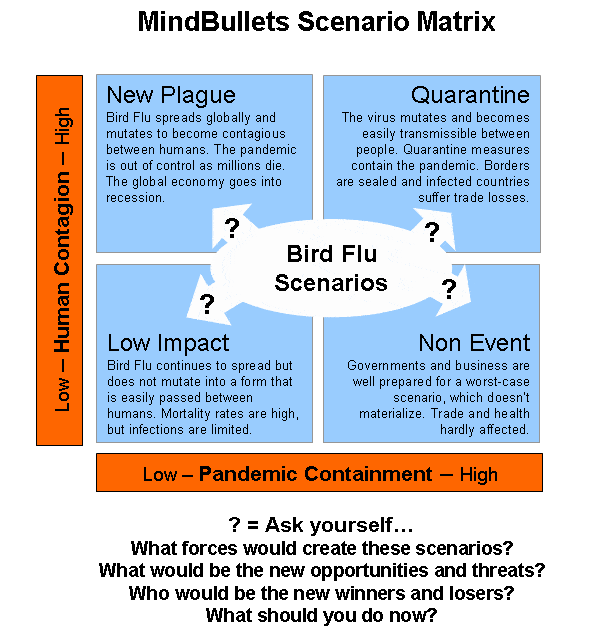BIRD FLU PLAGUE CONTAINED AMID VAST TRADE DISRUPTIONS

Scenarios speed business and government response
- Dateline
- 7 April 2009
The Bird Flu pandemic has been contained – thanks largely to the efforts of futurists and scenario planners, and the leaders who believed in them. Governments and business were well prepared for the eventual, inevitable, spread of Bird Flu to the global human population.
When avian flu mutated to a strain contagious between humans in 2008, some experts feared the worst, and predicted ‘hundreds of millions of deaths’ before the pandemic worked itself out. In fact, quick action to quarantine the outbreak, and vaccine response, prevented a complete catastrophe. Borders and airports were closed at the first sign of an outbreak, and an unprecedented collaboration by authorities on a global scale brought research and manufacture together to deliver the vaccines.
“Business and government leaders have seen the value of envisioning future scenarios, and their implications,” said Doug Vining of FutureWorld, a think tank that was one of the first to highlight the Bird Flu scenario, “and, more importantly, they acted on these ‘memories of the future’ when the first signs appeared.”
Some countries have been hard hit, mainly as a result of trade bans, and the global economy is expected to suffer a slow-down for several years.
Iran, with the highest death-toll, first blamed the CIA for introducing Bird Flu into the country, but is now offering to abandon their nuclear ambitions in return for emergency aid.
ANALYSIS >> SYNTHESIS: How this scenario came to be
THIS IS A STRATEGIC UPDATE TO THE BIRD FLU MINDBULLET AND CONSIDERS FOUR ALTERNATIVE SCENARIOS
Bird Flu, which started in South East Asia, has spread rapidly and infected birds have been found in Europe and Africa. It is only a matter of time before wild geese carry the virus to North America. Humans infected by poultry have exhibited a high mortality rate, over 50% in most recorded cases, but absolute numbers of deaths have been low as infections are contained, infected birds destroyed, and poultry vaccinated. But if the virus mutates to a form which is contagious among humans, then we face a global threat of a rampant pandemic which could kill tens of millions of people and reduce the global economy to tatters.
Preparedness on the part of authorities and business, for crisis management, early detection, vaccine development and distribution, and business continuity in the face of quarantines will determine the outcome. Technology can play its part, both for virus detection and identification and ensuring quarantine integrity, as well as assisting with vaccine development through biotech research.
Four likely scenarios are examined in this analysis.
Non Event
In this scenario, Bird Flu never mutates to a form which enables human-to-human transmission. Outbreaks occur among wild birds and poultry, but counter-measures are swift and effective. Birds are vaccinated, destroyed, and prevented from furthering the pandemic due to trade bans of associated products. Awareness of the risk is good, and the avian disease eventually subsides.
Low Impact
In the second scenario, human contagion remains low, but avian infections are not as easily contained. Mortality rates remain high, and although infection rates are relatively low, they continue among less prepared and vigilant communities. Travel warnings are issued, and border health checks become more frequent. Countries where infections occur suffer from reduced tourism and trade activity. Global economic impact is low.
The New Plague
In the worst-case scenario, the pandemic becomes rampantly transmissible between humans, with catastrophic results. Millions, possibly tens of millions die and panic is widespread. In a repeat of the Spanish Flu epidemic of 1918, countries become increasingly protective and inwardly focused. The global economy enters a recessionary spiral which will take decades to reverse. Rich countries ignore the plight of the Third World as they struggle to protect their own populations and industries. Mortality rates increase due to a shortage of vaccines. No countries escape the effect of the ‘plague’ and realize – too late – that collaboration and co-operation with the global community could have averted the disaster.
Quarantine
In the most likely scenario, the virus will eventually mutate into a strain (or several strains) which are fairly easily transmitted from human to human. However, government and business preparedness for this event will spur the efficient use of policy, technology and medical resources to quickly contain and manage the epidemic and its resulting disruptions. Technology will help in detecting infections and developing counter measures, as well as providing contingency plans such as tele-commuting to mitigate effects of travel restrictions. Flexibility in the face of disruption to traditional supply chains will be key to surviving this scenario, and China is possibly the most vulnerable to large scale quarantine measures. ‘Rogue’ nations such as North Korea and Iran could well find themselves at a disadvantage if they are adversely affected by contagious infections, as it will likely take a high level of international co-operation to prevent a global pandemic.

Links to related stories
- MindBullet: BIRD FLU PLAGUE ON ITS WAY TO USA AND EUROPE (Dateline: 25 April 2009, Published: 24 February 2005)
- MindBullet: COMPUTER VIRUS INFECTS HUMANS (Dateline 13 February 2022, Published 7 October 2004)
- MindBullet: BILL GATES REFUSED ENTRY AT HEATHROW TERMINAL 5 (Dateline: 6 February 2012, Published: 14 April 2005)
- MindBullet: DISASTERS NOW BIG BUSINESS (Dateline: 7 September 2009, Published: 13 October 2005)
- Scientists Study How Bird Flu Spreads - CBS News 22 March 2006
- 'Every man for himself' in Europe’s bird flu simulation - Financial Times 31 March 2006
- Is Business Ready for a Flu Pandemic? - New York Times 16 March 2006 (free subscription required)
Warning: Hazardous thinking at work
Despite appearances to the contrary, Futureworld cannot and does not predict the future. Our Mindbullets scenarios are fictitious and designed purely to explore possible futures, challenge and stimulate strategic thinking. Use these at your own risk. Any reference to actual people, entities or events is entirely allegorical. Copyright Futureworld International Limited. Reproduction or distribution permitted only with recognition of Copyright and the inclusion of this disclaimer.